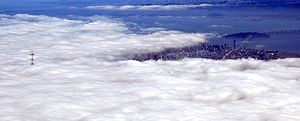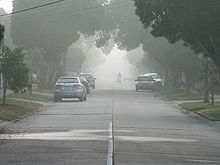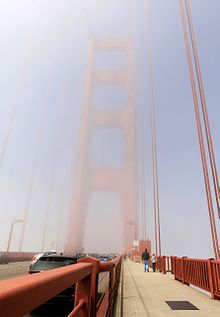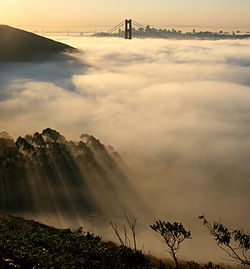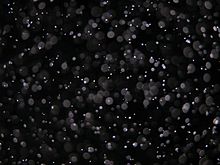- Fog
-
Part of the Nature series on
WeatherCalendar seasons Spring · Summer
Tropical seasonsStorms Thunderstorm · Supercell
Downburst · Lightning
Tornado · Waterspout
Tropical cyclone (Hurricane)
Extratropical cyclone
Winter storm · Blizzard · Ice storm
Dust storm · Firestorm · CloudPrecipitation Drizzle · Rain · Snow · Graupel
Freezing rain · Ice pellets · HailTopics Meteorology · Climate
Weather forecasting
Heat wave · Air pollutionWeather portal Fog is a collection of water droplets or ice crystals suspended in the air at or near the Earth's surface.[1] While fog is a type of a cloud, the term "fog" is typically distinguished from the more generic term "cloud" in that fog is low-lying, and the moisture in the fog is often generated locally (such as from a nearby body of water, like a lake or the ocean, or from nearby moist ground or marshes).[2] Fog is distinguished from mist only by its density, as expressed in the resulting decrease in visibility: Fog reduces visibility to less than 1 km (5/8 statute mile), whereas mist reduces visibility to no less than 1 km (5/8 statute mile).[3] For aviation purposes in the UK, a visibility of less than 2 km but greater than 999 m is considered to be mist if the relative humidity is 95% or greater - below 95% haze is reported.[citation needed]
The foggiest place in the world is the Grand Banks off the island of Newfoundland, the meeting place of the cold Labrador Current from the north and the much warmer Gulf Stream from the south. Some of the foggiest land areas in the world include Argentia, Newfoundland and Labrador and Point Reyes, California, each with over 200 foggy days per year. Even in generally warmer southern Europe, thick fog and localized fog is often found in lowlands and valleys, such as the lower part of the Po Valley and the Arno and Tiber valleys in Italy or Ebro Valley in northeastern Iberia, as well as on the Swiss plateau, especially in the Seeland area, in late autumn and winter.[citation needed] Other notably foggy areas include coastal Chile (in the south), coastal Namibia, and the Severnaya Zemlya islands. [4]
Contents
Characteristics
Fog forms when the difference between temperature and dew point is generally less than 2.5 °C or 4 °F.[5]
Fog begins to form when water vapor condenses into tiny liquid water droplets in the air. The main ways water vapor is added to the air: wind convergence into areas of upward motion,[6] precipitation or virga falling from above,[7] daytime heating evaporating water from the surface of oceans, water bodies or wet land,[8] transpiration from plants,[9] cool or dry air moving over warmer water,[10] and lifting air over mountains.[11] Water vapor normally begins to condense on condensation nuclei such as dust, ice, and salt in order to form clouds.[12][13] Fog, like its slightly elevated cousin stratus, is a stable cloud deck which tends to form when a cool, stable air mass is trapped underneath a warm air mass.[14]
Fog normally occurs at a relative humidity near 100%.[15] This can be achieved by either adding moisture to the air or dropping the ambient air temperature.[15] Fog can form at lower humidities, and fog can sometimes not form with relative humidity at 100%. A reading of 100% relative humidity means that the air can hold no additional moisture; the air will become supersaturated if additional moisture is added.
Fog can form suddenly, and can dissipate just as rapidly, depending what side of the dew point the temperature is on. This phenomenon is known as flash fog.[16]
Low lying fog over the more cool ocean surface in Vancouver, Canada during the 2010 Winter Olympics, which featured warmer temperatures mixed with high humidity.
Another common type of formation is associated with sea fog (also known as haar or fret). This is due to the peculiar effect of salt. Clouds of all types require minute hygroscopic particles upon which water vapor can condense. Over the ocean surface, the most common particles are salt from salt spray produced by breaking waves. Except in areas of storminess, the most common areas of breaking waves are located near coastlines, hence the greatest densities of airborne salt particles are there. Condensation on salt particles has been observed to occur at humidities as low as 70%, thus fog can occur even in relatively dry air in suitable locations such as the California coast. Typically, such lower humidity fog is preceded by a transparent mistiness along the coastline as condensation competes with evaporation, a phenomenon that is typically noticeable by beachgoers in the afternoon. Another recently-discovered source of condensation nuclei for coastal fog is kelp. Researchers have found that under stress (intense sunlight, strong evaporation, etc.), kelp release particles of iodine which in turn become nuclei for condensation of water vapor.[17]
Fog commonly produces precipitation in the form of drizzle or very light snow. Drizzle occurs when the humidity of fog attains 100% and the minute cloud droplets begin to coalesce into larger droplets.[18] This can occur when the fog layer is lifted and cooled sufficiently, or when it is forcibly compressed from above. Drizzle becomes freezing drizzle when the temperature at the surface drops below the freezing point.
The thickness of fog is largely determined by the altitude of the inversion boundary, which in coastal or oceanic locales is also the top of the marine layer, above which the airmass is warmer and drier. The inversion boundary varies its altitude primarily in response to the weight of the air above it which is measured in terms of atmospheric pressure. The marine layer and any fogbank it may contain will be "squashed" when the pressure is high, and conversely, may expand upwards when the pressure above it is lowering.
Visibility hazard
 Dense Tule fog in Bakersfield, California. Visibility in this photo is less than 500 feet (150 metres).
Dense Tule fog in Bakersfield, California. Visibility in this photo is less than 500 feet (150 metres).
Shadows
Shadows are cast through fog in three dimensions. The fog is dense enough to be illuminated by light that passes through gaps in a structure or tree, but thin enough to let a large quantity of that light pass through to illuminate points further on. As a result, object shadows appear as "beams" oriented in a direction parallel to the light source. These voluminous shadows are due to the same cause as crepuscular rays, which are the shadows of clouds, but in this case, they are the shadows of solid objects.
-
Fog shadow of Sutro Tower
Types
Fog can form in a number of ways, depending on how the cooling that caused the condensation occurred:
−25 °C (−13 °F) air temperature produces immense steam fog over Lake Ontario which is still above freezing.
Radiation fog is formed by the cooling of land after sunset by thermal radiation in calm conditions with clear sky.
The cool ground produces condensation in the nearby air by heat conduction. In perfect calm the fog layer can be less than a meter deep but turbulence can promote a thicker layer. Radiation fogs occur at night, and usually do not last long after sunrise, though can persist all day in the winter months especially in areas bounded by high ground such as the Vale of York in England. Radiation fog is most common in autumn and early winter. Examples of this phenomenon include the Tule fog.[19]
Ground fog is fog that obscures less than 60% of the sky and does not extend to the base of any overhead clouds.[20] However, the term is sometimes used to refer to radiation fog.
Advection fog occurs when moist air passes over a cool surface by advection (wind) and is cooled.[21] It is common as a warm front passes over an area with significant snowpack. It is most common at sea when tropical air encounters cooler waters, including areas of cold water upwelling, such as along the California coast. The advection of fog along the California coastline is propelled onto land by one of several processes. A cold front can push the marine layer coastward, an occurrence most typical in the spring or late fall. During the summer months, a low pressure trough produced by intense heating inland creates a strong pressure gradient, drawing in the dense marine layer. Also during the summer, strong high pressure aloft over the desert southwest, usually in connection with the summer monsoon, produces a south to southeasterly flow which can drive the offshore marine layer up the coastline; a phenomenon known as a "southerly surge", typically following a coastal heat spell. However, if the monsoonal flow is sufficiently turbulent, it might instead break up the marine layer and any fog it may contain. Moderate turbulence will typically transform a fog bank, lifting it and breaking it up into shallow convective clouds called stratocumulus.
Sea smoke, also called steam fog or evaporation fog, is the most localized form and is created by cold air passing over warmer water or moist land.[22] It often causes freezing fog, or sometimes hoar frost.
Arctic sea smoke is similar to sea smoke, but occurs when the air is very cold. Instead of condensing into water droplets, the evaporating water sublimates into ice crystals.
Precipitation fog (or frontal fog) forms as precipitation falls into drier air below the cloud, the liquid droplets evaporate into water vapor. The water vapor cools and at the dewpoint it condenses and fog forms.
Upslope fog or hill fog forms when winds blow air up a slope (called orographic lift), adiabatically cooling it as it rises, and causing the moisture in it to condense. This often causes freezing fog on mountaintops, where the cloud ceiling would not otherwise be low enough.
Valley fog forms in mountain valleys, often during winter. It is the result of a temperature inversion caused by heavier cold air settling into a valley, with warmer air passing over the mountains above. It is essentially radiation fog confined by local topography, and can last for several days in calm conditions. In California's Central Valley, valley fog is often referred to as Tule fog.
Freezing fog occurs when liquid fog droplets freeze to surfaces, forming white soft or hard rime.[22] This is very common on mountain tops which are exposed to low clouds. It is equivalent to freezing rain, and essentially the same as the ice that forms inside a freezer which is not of the "frostless" or "frost-free" type. The term "freezing fog" may also refer to fog where water vapor is super-cooled, filling the air with small ice crystals similar to very light snow. It seems to make the fog "tangible", as if one could "grab a handful".
Frozen fog (also known as ice fog) is any kind of fog where the droplets have frozen into extremely tiny crystals of ice in midair. Generally this requires temperatures at or below −35 °C (−30 °F), making it common only in and near the Arctic and Antarctic regions.[23] It is most often seen in urban areas where it is created by the freezing of water vapor present in automobile exhaust and combustion products from heating and power generation. Urban ice fog can become extremely dense and will persist day and night until the temperature rises. Extremely small amounts of ice fog falling from the sky form a type of precipitation called ice crystals, often reported in Barrow, Alaska. Ice fog often leads to the visual phenomenon of light pillars.
The phenomenon is also extremely common in the inland areas of the Pacific Northwest that, with temperatures in the 10 to 30°F range. The Columbia Plateau experiences this phenomenon most years due to temperature inversions, sometimes lasting for as long as three weeks. The fog typically begins forming around the area of the Columbia River and expands, sometimes covering the land to distances as far away as LaPine, Oregon, almost 150 miles due south of the River and into south central Washington.
Artificial fog is artificially generated fog that is usually created by vaporizing a water and glycol-based or glycerine-based fluid. The fluid is injected into a heated block, and evaporates quickly. The resulting pressure forces the vapor out of the exit. Upon coming into contact with cool outside air the vapor condenses and appears as fog.[24]
Garua fog is a type of fog which happens to occur by the coast of Chile and Peru.[25] The normal fog produced by the sea travels inland, but suddenly meets an area of hot air. This causes the water particles of fog to shrink by evaporation, producing a transparent mist. Garua fog is nearly invisible, yet it still forces drivers to use windshield wipers.
Hail fog sometimes occurs in the vicinity of significant hail accumulations due to decreased temperature and increased moisture leading to saturation in a very shallow layer near the surface. It most often occurs when there is a warm, humid layer atop the hail and when wind is light. This ground fog tends to be localized but can be extremely dense and abrupt. It may form shortly after the hail falls; when the hail has had time to cool the air and as it absorbs heat when melting and evaporating.[26]
Biological and human uses
Redwood forests in California receive approximately 30 to 40 percent of their moisture from coastal fog. Change in climate patterns could result in relative drought in these areas.[27] Some coastal communities use fog nets to extract moisture from the atmosphere where groundwater pumping and rainwater collection are insufficient.
See also
Technology
- Anti-fog
- Automotive lighting
- Decontamination foam
- FIDO
- Fog machine
- Fogging (photography)
- Fog lamp
- Runway visual range
- Transmissometer
Weather
- Fog season
- Haboob (sandstorm)
- Mist
- Smog
- Whiteout (weather)
Notes
- ^ "The international definition of fog consists of a suspended collection of water droplets or ice crystal near the Earth's surface ..." Fog and Boundary Layer Clouds: Fog Visibility and Forecasting. Gultepe, Ismail, ed. Reprint from Pure and Applied Geophysics Vol 164 (2007) No. 6-7. ISBN 9783764384180. p. 1126; see Google Books Accessed 2010-08-01.
- ^ Use of the term "fog" to mean any cloud that is at or near the Earth's surface can result in ambiguity as when, for example, a stratocumulus cloud covers a mountaintop. An observer on the mountain may say that he or she is in a fog, however, to outside observers a cloud is covering the mountain. "Standard practice for the design and operation of supercooled fog dispersal projects" Thomas, P. (2005) p. 3. ISBN 0784407959 See Google Books. Accessed 2010-08-01. Further distinguishing the terms, fog rarely results in rain, while clouds are the common source of rain.
- ^ "Federal Meteorological Handbook Number 1: Chapter 8 - Present Weather". Office of the Federal Coordinator for Meteorology. 2005-09-01. pp. 8-1, 8-2. http://www.ofcm.gov/fmh-1/pdf/H-CH8.pdf. Retrieved 2010-10-09.
- ^ "Q: What are some of the foggiest locations in the world?". USA Today.
- ^ "Fog - AMS Glossary". http://amsglossary.allenpress.com/glossary/search?id=fog1. Retrieved 2009-02-14.
- ^ Robert Penrose Pearce (2002). Meteorology at the Millennium. Academic Press. p. 66. ISBN 978-0-12-548035-2. http://books.google.com/?id=QECy_UBdyrcC&pg=PA66&lpg=PA66&dq=ways+to+moisten+the+atmosphere. Retrieved 2009-01-02.
- ^ National Weather Service Office, Spokane, Washington (2009). "Virga and Dry Thunderstorms". http://www.wrh.noaa.gov/otx/outreach/ttalk/virga.php. Retrieved 2009-01-02.
- ^ Bart van den Hurk and Eleanor Blyth (2008). "Global maps of Local Land-Atmosphere coupling". KNMI. http://www.knmi.nl/~hurkvd/Loco_workshop/Workshop_report.pdf. Retrieved 2009-01-02.
- ^ Krishna Ramanujan and Brad Bohlander (2002). "Landcover changes may rival greenhouse gases as cause of climate change". National Aeronautics and Space Administration Goddard Space Flight Center. Archived from the original on June 3, 2008. http://web.archive.org/web/20080603022239/http://www.gsfc.nasa.gov/topstory/20020926landcover.html. Retrieved 2009-01-02.
- ^ National Weather Service JetStream (2008). "Air Masses". http://www.srh.weather.gov/srh/jetstream/synoptic/airmass.htm. Retrieved 2009-01-02.
- ^ Dr. Michael Pidwirny (2008). "CHAPTER 8: Introduction to the Hydrosphere (e). Cloud Formation Processes". Physical Geography. http://www.physicalgeography.net/fundamentals/8e.html. Retrieved 2009-01-01.
- ^ Glossary of Meteorology (June 2000). "Front". American Meteorological Society. http://amsglossary.allenpress.com/glossary/search?id=front1. Retrieved 2010-01-29.
- ^ David M. Roth (2006-12-14). "Unified Surface Analysis Manual". Hydrometeorological Prediction Center. http://www.hpc.ncep.noaa.gov/sfc/UASfcManualVersion1.pdf. Retrieved 2010-10-09.
- ^ FMI (2007). "Fog And Stratus - Meteorological Physical Background". Zentralanstalt für Meteorologie und Geodynamik. http://www.zamg.ac.at/docu/Manual/SatManu/main.htm?/docu/Manual/SatManu/CMs/FgStr/backgr.htm. Retrieved 2009-02-07.
- ^ a b Gleissman, 2007, p. 73
- ^ Miles, Kathy (October 2007). Just About Everything You Wanted to Know about Fog. Starryskies.com.
- ^ Stressed seaweed contributes to cloudy coastal skies, study suggests, eurekalert.org
- ^ Allred, 2009, p. 99.
- ^ Cox, Robert E. Applying Fog Forecasting Techniques using AWIPS and the Internet. National Weather Service, 2007. nwas.org
- ^ Climate education update: News and information about climate change for teachers and students. Atmospheric Radiation Measurement. Climate Research Facility. U.S. Department of Energy. education.arm.gov
- ^ Frost, 2004, p. 22.
- ^ a b Understanding Weather - Fog. BBC Weather. bbc.co.uk
- ^ Haby, Jeff. What is the difference between ice fog and freezing fog? theweatherprediction.com
- ^ Karukstis; Van Hecke, 2003, p.23.
- ^ Cowling; Richardson; Pierce, 2004, p. 192.
- ^ Marshall; Hoadley, 1995.
- ^ "Fog Fluctuations Could Threaten Giant Redwoods". http://www.npr.org/templates/story/story.php?storyId=123771983&ft=1&f=1001.
References
- Ahrens, C. (1991). Meteorology today: an introduction to weather, climate, and the environment. West Pub. Co. ISBN 978-0314809056.
- Allred, Lance (2009). Enchanted Rock: A Natural and Human History. University of Texas Press.
- Cowling, R. M., Richardson, D. M., Pierce, S. M. (2004). Vegetation of Southern Africa. Cambridge University Press.
- Filonczuk, Maria K., Cayan, Daniel R., Riddle, Laurence G. (1995). Variability of marine fog along the California coast. SIO-Reference, No 95-2, Climate Research Division, Scripps Institution of Oceanography, University of California, San Diego.
- Frost, H. (2004). Fog. Capstone Press. ISBN 978-0736820936.
- Gleissman, Stephe (2007). Agroecology: the ecology of sustainable food systems. CRC Press.
- Karukstis, K. K., Van Hecke, G. R. (2003). Chemistry connections: the basis of everyday phonemena. Academic Press.
- Marshall, T., Hoadley, D. (1995). Storm Talk. Tim Marshall.
External links
- Map of the United States showing days of heavy fog in each location
- United States' current dense fog advisories from NOAA
- Current Western US fog satellite pictures from NOAA
- Lake Ontario Evaporative-Steam Fog Video
- Social & Economic Costs of Fog from "NOAA Socioeconomics" website initiative
Meteorological data and variables General Adiabatic processes · Lapse rate · Lightning · Surface solar radiation · Surface weather analysis · Visibility · Vorticity · WindCondensation Convection Temperature Dew point (Td) · Equivalent temperature (Te) · Forest fire weather index · Haines Index · Heat index · Humidex · Humidity · Potential temperature (θ) · Equivalent potential temperature (θe) · Sea surface temperature (SST) · Wet-bulb temperature · Wet-bulb potential temperature · Wind chillPressure Cloud genuses Extreme-level High-level Medium-level Low-level Fog · Stratus (St) · Cumulus (Cu) · Stratocumulus (Sc) · Arcus (Roll) · Fractus · Funnel · Nimbostratus (Ns) · Shelf · Wall · Actinoform cloud · Undulatus asperatusVertical Cumulonimbus (Cb) · Cumulonimbus mammatus · Pyrocumulus · Pyrocumulonimbus · Overshooting top · AccessoryCategories:- Weather hazards to aircraft
- Accidents involving fog
- Snow or ice weather phenomena
- Fog
- Psychrometrics
Wikimedia Foundation. 2010.

